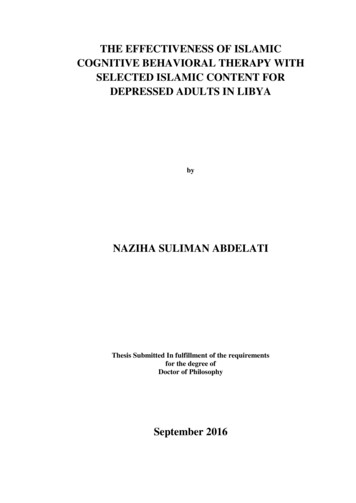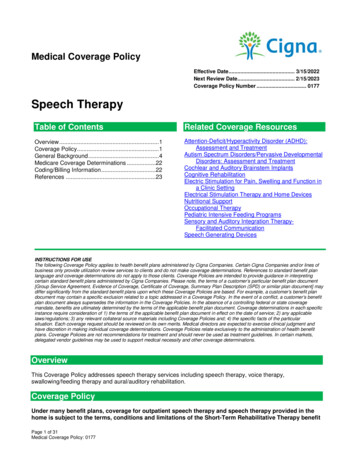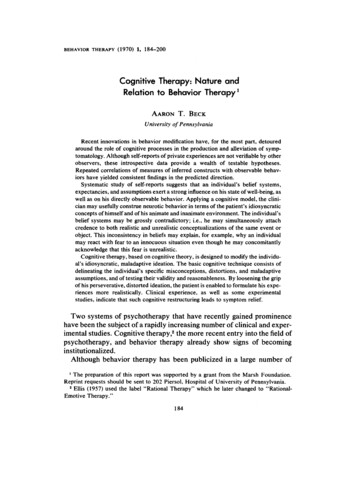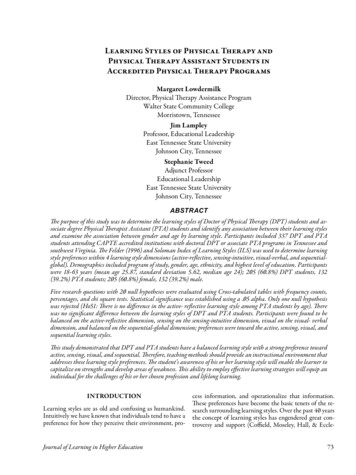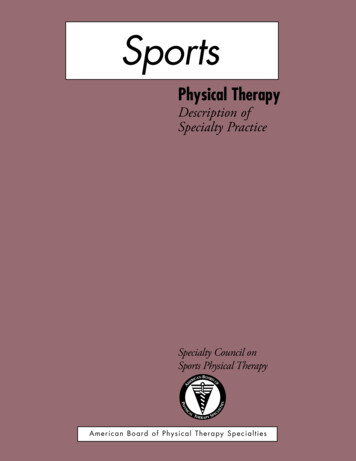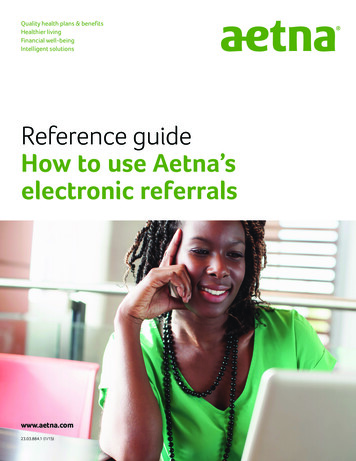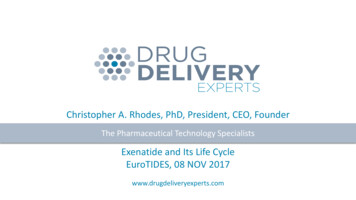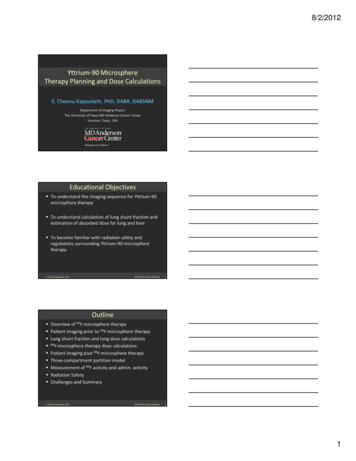
Transcription
8/2/2012Yttrium-90 MicrosphereTherapy Planning and Dose CalculationsS. Cheenu Kappadath, PhD, DABR, DABSNMDepartment of Imaging PhysicsThe University of Texas MD Anderson Cancer CenterHouston, Texas, USAEducational Objectives To understand the imaging sequence for Yttrium-90microsphere therapy To understand calculation of lung shunt fraction andestimation of absorbed dose for lung and liver To become familiar with radiation safety andregulations surrounding Yttrium-90 microspheretherapyS. Cheenu Kappadath, PhDAAPM 2012 Annual Meeting2Outline Overview of 90Y-microsphere therapyPatient imaging prior to 90Y-microsphere therapyLung shunt fraction and lung dose calculations90Y-microsphere therapy dose calculationsPatient imaging post 90Y-microsphere therapyThree-compartment partition modelMeasurement of 90Y activity and admin. activityRadiation SafetyChallenges and SummaryS. Cheenu Kappadath, PhDAAPM 2012 Annual Meeting31
8/2/201290Y-microsphereTherapyradioactive 90Y-labeled Trans-arterial delivery ofmicrospheresvia a catheter directly at disease sites (targeted infusion) Microspheres (20-30 µm) trapped in tumor capillary vesselsdue to their embolic size and targeted delivery TheraSphere SIRTEX β emissions from trapped 90Y-microspheres are capable ofdelivering lethal radiation doses to (proximal) neoplastictissue while sparing (more distal) surrounding normal tissueS. Cheenu Kappadath, PhDAAPM 2012 Annual Meeting90Y-microsphere 90Y-microsphere therapy usually 90Y-microsphere therapy takes4Therapytarget the liveradvantage of the uniquecirculatory system in the liver– Portal vein (normal liver) & hepatic artery (tumor) Liver directed XRT are limited in scope– Radiation tolerance of normal hepatocytes neoplastic tissue– Max. tolerated doses 30–40 Gy (Emami et al, IJROBP 21, 1991; McGinn et al, J Clin Onc 16, 1998) With 90Y-microspheres, total liver radiation doses up to 80 Gywere well tolerated with no hepatic radiation damage (Gray et al,Annals Oncology 12, 2001; Burton et al, Radiology 175, 1990) 90Y-microsphere therapy isapproved by the FDA for thetreatment of unresectable HCC and metastatic colorectalcancerS. Cheenu Kappadath, PhDAAPM 2012 Annual Meeting5Properties of Yttrium-90 Decay: Y-90 (β-, 64.1 hr) Zr-90; a pure β- emitter– Y-90 also emits β at low yields ( 32 ppm) via internal pair-production β energy: 0.937 MeV (mean) and 2.28 MeV (max) Tissue penetration depth: 2.5 mm (mean) and 11 mm (max) 90Y deposits 90% of its energy in the first 5 mm of tissue 90Y deposits 90% of its energy in the first 11 days Permanently implanted 90Y can deliver radiation absorbed doses of 50 Gy for 1 GBq of activity per kilogram of tissue(Berger, JNM 12, 1971)(Sarfaraz et al., Med Phys 31, 2004)S. Cheenu Kappadath, PhDAAPM 2012 Annual Meeting62
8/2/2012Commercial 90Y-microsphere ProductsSIR-Spheres TheraSphere Sirtex Medical, Sydney, Australia Insoluble, biocompatible resinmatrix 30–35 µm glass spheres 3 GBq (81 mCi) activity 30–60 x 106 spheres Maximum activity available:3 GBq (81 mCi) MDS Nordion, Ottawa, Canada Insoluble, biocompatible glassmatrix 20–30 µm glass spheres 3 GBq (81 mCi) activity 1.2 x 106 spheres Maximum activity available:20 GBq (540 mCi) Indicated for the treatment ofunresectable metastatic livertumors from primary colorectalcancer with adjuvantchemotherapy (FUDR) Indicated for radiation treatmentor as a neoadjuvant for surgery ortransplantation in patients withunresectable HCCLiver is common site of metastases from a variety of neoplasms Clinical trials on management of metastatic liver diseaseS. Cheenu Kappadath, PhDAAPM 2012 Annual Meeting7Patient Imaging Prior to 90Y Therapy CT or MRI – Estimate target tumor mass IR – Selective embolize aberrant/hepatic vasculature– Int. Radiologist under fluoroscopic guidance in an angiography suite NM – 99mTc-MAA Planar and/or SPECT imaging– MAA used as a surrogate for microspheres– Assess TA catheter placement and perfusion of targeted tumors Calculate lung shunt factor and lung dose Determine treatment dose/activity(Hall et al., J Int Onc 2, 2009)S. Cheenu Kappadath, PhDAAPM 2012 Annual Meeting8Lung Dose Consideration Prevention of radiation pneumonitis– Arterio-venous shunting in neoplastic vasculature– Tc-99m MAA scans used to assess lung shunt fraction andlung dose– Exclude patients with lung shunting that could result inlung radiation dose 25-30 Gy per treatment or 50 Gy(Ho et al, EJNM 24, 1997)cumulativeSIR-SpheresTheraSphereLung ShuntingReduction FactorLung Dose Limit 10 %No ReductionPer TreatmentGy3010 % - 15 %20 % reductionCumulative5015 % - 20 %40 % reduction 20 %No TreatmentLung dose per treatment 25 GyS. Cheenu Kappadath, PhDAAPM 2012 Annual Meeting93
8/2/2012Lung Shunt (LS) Fraction 2-4 mCi of 99mTc-MAA delivered trans-arterially in IR suite Planar scintigraphy of Thorax and Abdomen (AP and PA) Calculate Lung Shunt (LS) using the following formulaLung CountsLungShunt (%) 100Lung Counts Liver CountsGM counts ANTcounts POSTcounts SIR-Spheres:geometric-meanimages TheraSphere:not specifiedS. Cheenu Kappadath, PhDAAPM 2012 Annual Meeting10Example Lung Shunt CalculationLS (%) Lung GM-counts / (Lung GM-counts Liver GM-counts) x 100 77278 / (77278 973962) x 100 7.35%– SIR-Spheres:LS 10% (no modification) 81 mCi 90Y activity limit– TheraSphere:30 Gy lung dose limit 222 mCi 90Y activity limitS. Cheenu Kappadath, PhDAAPM 2012 Annual Meeting90Y-Therapy11Planning: SIR-Spheres SIR-Spheres therapy doses are based on activity (not targetradiation dose) – maximum activity of 81 mCi Empirical dosimetry models– Basic: Activity based on maximum activity & tumor fraction– BSA: Activity based on BSA & tumor involvement in liver– Lung Shunt modification: No treatment for LS 20% Average liver dose 80 Gy and lung dose 25 GyLung-Shunt Fraction ModificationTumor Fraction ModificationTumor fraction inliverRecommendedactivityLung Shunting90Y- 50 %3.0 GBq (81 mCi)25 - 50 %2.5 GBq (67.5 mCi) 25 %2.0 GBq (54 mCi)S. Cheenu Kappadath, PhDReduction Factor 10 %No Reduction10 % - 15 %20 % reduction15 % - 20 %40 % reduction 20 %No TreatmentLung dose per treatment 25 GyAAPM 2012 Annual Meeting124
8/2/201290Y-TherapyPlanning: TheraSphere TheraSphere therapy doses are based on desired radiationdose to target mass; typically 120 to 150 GyActivity Required [GBq] Desired Dose [Gy] x Target Mass [kg]50 [Gy - kg/GBq] Target mass whole liver or liver lobe or liver segment– Patient-specific vasculature and catheter approach (common or left orright hepatic artery) to target mass defines target mass Therapy must maintain lung dose lower than 30 Gy– Maximum activity depends on the Lung Shunt fractionS. Cheenu Kappadath, PhDAAPM 2012 Annual Meeting13Radiation Absorbed Dose Dosetissue [Gy] Atissue [GBq] x 49.7 [Gy-kg/GBq] / Mtissue [kg]– Self dose from β emission: 90% energy deposit in 5mm– 49.7 [Gy-kg/GBq] equilibrium accumulated dose constant– Bremsstrahlung dose β dose(Berger, JNM 12, 1971; Stabin et al, JNM 35, 1994; Gulec et al, JNM 47, 2006)Liver ActivityLiver Dose [Gy] A [GBq] x (1-LS) x 49.7 [Gy-kg/GBq] / Mliver [kg]Lung Dose [Gy] A [GBq] x LS x 49.7 [Gy-kg/GBq] / Mlung [kg]Lung Activity Error in liver mass propagates into liver dose calculation Model estimates average dose to target volume assuminguniform microsphere uptake within volumeS. Cheenu Kappadath, PhDAAPM 2012 Annual Meeting14Dose Calculations: TheraSphereMax Activity [mCi] 30 [Gy] x Mlung [kg] / (LS x 0.037 [GBq/mCi] x49.7 [Gy-kg/GBq])Activity [mCi] Dliver [Gy] x Mliver [kg] / ((1-LS) x 0.037 [GBq/mCi]x 49.7 [Gy-kg/GBq]) Lung Shunt Maximum Activity Liver dose [Gy] 0.0735 222 mCi, for lung dose 30 Gy 378 [Gy-kg] / Mliver [kg] 198 Gy for Mliver 1.91 kg (MIRD Std. Man) 154 Gy for Mliver 2.46 kg (Weight-based) 137 Gy for Mliver 2.76 kg (CT-based) Target liver dose 120 Gy 134.6 mCi of 90Y Lung dose delivered 18.2 GyS. Cheenu Kappadath, PhDAAPM 2012 Annual Meeting155
8/2/2012Dose Calculations: SIR-SpheresM, 53 kg, 174.5 cm BSA 1.60 m2Tumorinvolvement (TI)45%Dose modification YESLung Shunt (LS)7.35%Dose modification NOBasic model: 2.5 GBq (67.5 mCi)BSA model: (BSA[m2] – 0.2) TI[%]/100 1.85 GBq (50.1 mCi)Liver Dose [Gy] A [GBq] x (1-LS) x 49.7 [Gy-kg/GBq] / Mliver [kg] 44.7 Gy ( 80 Gy)Lung Dose [Gy] A [GBq] x LS x 49.7 [Gy-kg/GBq] / Mlung [kg] 6.8 Gy ( 25 Gy)S. Cheenu Kappadath, PhDAAPM 2012 Annual Meeting16Patient imaging on day of 90Y-Therapy Interventional Radiologist in Angiography suite– verify catheter placement, assess flow– deliver 90Y-microspheres NM Planar & SPECT 90Y-bremsstrahlung imaging– 79keV/26% window, MELP collimation, 128x128 matrix, 4.8 mm2 pixels, 128views/360 , 28 s/view, non-circular step-shoot– Assess delivery and distribution of 90Y-microspheres Follow-up evaluations at2-3 months – CT or MRICounts (arbitrary)90Y Spectra0100200300400500600Photon Energy (keV)S. Cheenu Kappadath, PhDAAPM 2012 Annual Meeting17Pre and Post 90Y-microsphere therapyPRIORTHERAPYCT 3-June-2008POSTCT 5-Sept-2008Y-90 SPECT/CT2-July-2008Tc-99m MAA SPECT/CT24-June-2008S. Cheenu Kappadath, PhDTc-99m MAA SPECT/CT2-Sept-2008AAPM 2012 Annual Meeting186
8/2/2012SPECT Concordance: 99mTc-MAA & 90YTc-99m MAASPECT/CT24-June-2008Y-90 SPECT/CT2-July-2008Fused SPECT:Tc-99m MAAand Y-90S. Cheenu Kappadath, PhDAAPM 2012 Annual Meeting19SAM Question 1The physical properties of Yttrium-90 thatmakes it well suited for internal radionuclidetherapy are that 90Y is a pure β - emitter with amax. energy of 2.28 MeV corresponding to a:23% A. maximum tissue penetration depth of 0.1 mm25% B. maximum tissue penetration depth of 1 mm28% C. maximum tissue penetration depth of 10 mm25% D. maximum tissue penetration depth of 100 mmS. Cheenu Kappadath, PhDAAPM 2012 Annual Meeting20SAM Question 1: Answer The physical properties of Yttrium-90 that makes itwell suited for internal radionuclide therapy are that90Y is a pure β - emitter with a maximum energy of2.28 MeV corresponding to a:A.B.C.D. maximum tissue penetration depth of 0.1 mmmaximum tissue penetration depth of 1 mmmaximum tissue penetration depth of 10 mmmaximum tissue penetration depth of 100 mmReference: Sarfaraz M, Kennedy AS, Lodge MA, Li XA, Wu X, Yu CX, “Radiationabsorbed dose distribution in a patient treated with yttrium-90 microspheres forhepatocellular carcinoma,” Medical Physics 31(9):2449-53, 2004S. Cheenu Kappadath, PhDAAPM 2012 Annual Meeting217
8/2/2012SAM Question 2The most common route of 90Y-microsphereadministration for liver–directed therapy is:24% A. Peri-tumoral injection25% B. Implantation of 90Y-brachytherapy seeds25% C. Systematic administration via intravenous injection26% D. Trans-hepatic arterial administration via catheterS. Cheenu Kappadath, PhDAAPM 2012 Annual Meeting22SAM Question 2: Answer The most common route of 90Y-microsphereadministration for liver–directed therapy is:A.B.C.D. Peri-tumoral injectionImplantation of 90Y-brachytherapy seedsSystematic administration via intravenous injectionTrans-hepatic arterial administration via catheterReference: Murthy R, Nunez R, Szklaruk J, et al., “Yttrium-90 microsphere therapyfor hepatic malignancy: devices, indications, technical considerations, andpotential complications,” Radiographics 25(Supplement 1):S41-55, 2005S. Cheenu Kappadath, PhDAAPM 2012 Annual Meeting23SAM Question 3The lung shunt fraction (LSF) based on 99mTcMAA Planar images, used to estimate lungabsorbed doses from 90Y-microsphere therapy,is calculated as:Lung Shunt Fraction (%) LungCounts 100Liver CountsLung Shunt Fraction (%) Liver Counts 100Lung CountsC.Lung Shunt Fraction (%) Lung Counts 100Lung Counts Liver CountsD.Lung Shunt Fraction (%) Lung Counts Liver Counts 100Lung Counts23%A.26%B.27%25%S. Cheenu Kappadath, PhDAAPM 2012 Annual Meeting248
8/2/2012SAM Question 3: Answer The lung shunt fraction (LSF) based on 99mTc-MAAPlanar images, used to estimate lung absorbed dosesfrom 90Y-microsphere therapy, is calculated as: A.LungShunt Fraction (%) LungCounts 100Liver CountsB.Lung Shunt Fraction (%) Liver Counts 100Lung CountsC.Lung Shunt Fraction (%) Lung Counts 100Lung Counts Liver CountsD.Lung Shunt Fraction (%) Lung Counts Liver Counts 100Lung CountsReference: Gulec S, Mesoloras G, Stabin M, “Dosimetric techniques in 90Ymicrosphere therapy of liver cancer: The MIRD equations for dose calculations,” JNuclear Medicine 47:1209–11, 2006S. Cheenu Kappadath, PhDAAPM 2012 Annual Meeting25SAM Question 4The typical range of planned absorbed doses totarget liver tissue in 90Y-microsphere internalradionuclide therapies is around:25% A. 40 – 60 cGy24% B. 80 – 120 cGy27% C. 40 – 60 Gy25% D. 80 – 120 GyS. Cheenu Kappadath, PhDAAPM 2012 Annual Meeting26SAM Question 4: Answer The typical range of planned absorbed doses totarget liver tissue in 90Y-microsphere internalradionuclide therapies is around:A. 40 – 60 cGyB. 80 – 120 cGyC. 40 – 60 GyD. 80 – 120 Gy Reference: Salem R, Thurston KG, “Radioembolization with 90Yttriummicrospheres: a state-of-the-art brachytherapy treatment for primary andsecondary liver malignancies—Part 1: Technical and methodologic considerations,”J Vasc Interv Radiology 17:1251–1278, 2006S. Cheenu Kappadath, PhDAAPM 2012 Annual Meeting279
8/2/2012Limitations of Planning Dosimetry Not intended to calculate dose to individual tumors Uses conservative assumptions to ensure safety Assumes uniform uptake of microspheres in tumor andnormal liver compartmentsBasic model:Uniform Liver & Tumor Uptake3-Compartment model:Different Liver & Tumor UptakeRealistic model: Different Liver andHeterogeneous Tumor Uptake Three-compartment model: lung, liver, and tumor– Accounts for differential uptake of microspheres in liver versus tumor– All tumors, independent of their sizes or locations, grouped into thetumor compartment with a single uptake value (Ho et al., EJNM 23, 947-52, 1996)S. Cheenu Kappadath, PhDAAPM 2012 Annual Meeting28Three-compartment Partition model Additional information needed(Ho et al., EJNM 23, 947-52, 1996)– Tumor burden (Mtumor) and Tumor uptake ratio (R) Estimation of fractional Tumor Involvement (TI)– Mtotal Mliver Mtumor– Mtumor TI x Mtotal and Mliver (1-TI) x Mtotal Estimation of Tumor Uptake Ratio (R)R Tumor MAA uptake [counts/pixel]Liver MAA uptake [counts/pixel] Aliver [mCi] A [mCi] x (1-LS) x Mliver / (Mliver R x Mtumor) Atumor [mCi] A [mCi] x (1-LS) x R x Mtumor / (Mliver R x Mtumor) Doseorgan [Gy] Aorgan [GBq] x 49.7 [Gy-kg/GBq] / Morgan [kg]S. Cheenu Kappadath, PhDAAPM 2012 Annual Meeting29Example Calculation: Dose LS 7.35%Total Activity 222 mCiTotal liver 2.76 kgTI 45%T/N: R 632.9/32.8 19.3 Normal Liver– Mass 1.52 kg– Activity 12.3 mCi– Dose 14.7 Gy Tumor– Mass 1.24 kg– Activity 193.4 mCi– Dose 284.5 Gy Prior estimate of liver dose 137 Gy with T/N 1S. Cheenu Kappadath, PhDAAPM 2012 Annual Meeting3010
8/2/2012Three Compartment Model Dose Estimates(MacLellan &Kappadath,SNM 2012) 3CM doses are relatively insensitive to tumor uptake threshold levels 3CM yielded higher doses to tumor and lower doses to normal livercompared to BSA for both 99mTc-MAA and 90Y-bremssthralung SPECT/CT Differences in calculated dose between the 3CM and BSA models arelarger for the 99mTc-MAA scans than with the 90Y scansS. Cheenu Kappadath, PhDAAPM 2012 Annual Meeting31Three Compartment Model Dose Estimates(MacLellan & Kappadath,SNM 2012) Significant correlation (p 0.001 @75% isocount threshold) was observedbetween the 90Y and 99mTc-MAA tumor dose estimates but not for normalliver dose estimates The 90Y images yielded lower estimates for tumor doses (72% on averageat 75% threshold) and higher normal liver doses (150% on average at 75%threshold)S. Cheenu Kappadath, PhDAAPM 2012 Annual Meeting90Y-PET/CT 32Images90Yalso emits β at low yields (31.9 0.5 ppm) viainternal pair-production of 0 –0 transition of 90Zr(Greenberg & Deutsch 1956, Selwyn et al, 2007)(Kappadath & Mawlawi, SNM 2011)(Gates et al., JNM 52, 2011)S. Cheenu Kappadath, PhDAAPM 2012 Annual Meeting3311
8/2/2012Assay of 90Y Activity Dose calibration setting determined on-site with calibrated 90Y activityDose Calibrator n Number47 x 1047 x 1047 x 1047 x 1047 x 1045 x 1046 x 10 SIR-Spheres– Activity delivered as 81 mCi microspheres in water, 5 ml total volume– Draw microsphere solution by volume to desired activity804851616334803446S. Cheenu Kappadath, PhDAAPM 2012 Annual Meeting34Assay of 90Y Activity TheraSphere– Modification of the delivered activity is not allowed– Ordered activity would account for day/time of therapyS. Cheenu Kappadath, PhDAAPM 2012 Annual Meeting35Calculation of Administered Activity Percentage of activity delivered to the patient can be based on ionchamber exposure rate measurements– Before administration: dose-vial in acrylic shield– After administration: the 2L Nalgene jar with beta shield containing waste andresidual activity50 cm50 cm The percentage of activity delivered to the patient Waste measurement after therapy Activity Delivered [%] 100 1 Dose vial measurement before therapy Activity delivered to patientActivity Delivered [mCi] Dose Vial Activity [mCi] Activity Delivered [%] / 100S. Cheenu Kappadath, PhDAAPM 2012 Annual Meeting3612
8/2/201290Y-microsphereTherapy Preparation TheraSphereS. Cheenu Kappadath, PhDAAPM 2012 Annual Meeting37Radiation Safety Transport– Acrylic shield will stop all beta emission and keep exposure rate low– 2 mR/hr at 1 m for up to 300 mCi of activity in acrylic shield During administration– Highest potential for exposure is to administering staff in IR suitewhen spheres are located in catheter between v-vial and the patient– Stand behind shield and maintain distance Survey personnel leaving the room with GM survey meter Store radioactive material until the container surfaceradioactivity cannot be distinguished from background Long-lived contaminants 91Y and 88Y may be present withreactor production of 90Y– Long-lived radioactive by-products may not be a problem using carrierfree 90Y from a 90Sr generatorS. Cheenu Kappadath, PhDAAPM 2012 Annual Meeting38Some Challenges for 90Y-Therapy ROIs on 2D Planar images introduce uncertainties– Estimate lung shunt fraction and lung dose– Split dose calculation – lobar separation of liver not visualized MAA is a sub-optimal surrogate for microspheres– Biologic degradation time 1–3 hours free 99mTc-pertechnatate– Free 99mTc biodistribution differs from MAA; thyroid & stomachuptakes free 99mTc introduce error in LSF– Non-spherical shape; Size range 10-to-100 µm Additional objective measures of response– Tumor volume reduction is the mainstay (Gray et al, Aus & NZ J Surgery 62, 1992; VanHazel et al, J Sur Onc 88, 2004; Lau et al, IJROBP 40, 1998; Sangro et al, IJROBP 66, 2006)– Metabolic response: observed in higher proportion than an CT-basedanatomical response for mCRC (p 0.0002) (Wong et al, EJNMMI 29, 2002)– Functional response: 50% change in TLG at 6 weeks for mCRC lesionswith tumor doses 46 Gy (Flamen et al, PMB 53, 2008)S. Cheenu Kappadath, PhDAAPM 2012 Annual Meeting3913
8/2/2012Summary 90Y-microsphere therapy isa promising and an increasinglypopular treatment option for palliative care of patients withmetastatic liver disease and unresectable HCC Decreased tumor volumes and increased time to tumorprogression have been reported New objective measures of response are under investigation Improved imaging and dosimetry are beginning to yield moreaccurate dose estimatesS. Cheenu Kappadath, PhDAAPM 2012 Annual Meeting4014
Calculate lung shunt factor and lung dose Determine treatment dose/activity (Hall et al., J Int Onc 2, 2009) S. Cheenu Kappadath, PhD AAPM 2012 Annual Meeting 9 Lung Dose Consideration Prevention of radiation pneumonitis -Arterio-venous shunting in neoplastic vasculature -Tc-99m MAA scans used to assess lung shunt fraction and lung dose
